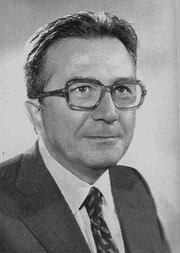Pentapartito
Five-Party Alliance Pentapartito | |
|---|---|
| Leaders | Olive Tree |
| Headquarters | Rome |
| Ideology | Christian democracy (DC) Social democracy (PSI, PDSI) Social liberalism (PRI) Conservative liberalism (PLI) |
The Pentapartito (from
History
This section needs additional citations for verification. (December 2017) |
New majority

The Pentapartito began in 1981 at a meeting of the Congress of the Italian Socialist Party (PSI) when the Christian Democrat Arnaldo Forlani and Socialist Secretary Bettino Craxi signed an agreement with the blessing of Giulio Andreotti. As the agreement was signed in a trailer, it was called the "pact of the camper." The pact was also called "CAF" for the initials of the signers, Craxi-Andreotti-Forlani. With this agreement, the DC party recognized the equal dignity of the so-called "secular parties" of the majority (i.e., the Socialists, Social Democrats, Liberals and Republicans) and also guaranteed an alternation of government (in fact, Giovanni Spadolini of the PRI and Bettino Craxi of the PSI became the first non-Christian Democrats to hold the premiership). With the birth of the Pentapartito, the possibility of the growth of the majority toward the Italian Communist Party (PCI) was finally dismissed. The Christian Democrats remained the leaders of the coalition, and managed several times to prevent representatives of the secular parties from becoming Prime Minister (Ciriaco De Mita was opposed, for example, by a continuous veto against Craxi).
Other sources, however, claim that the "pact of the camper" was only stipulated between Craxi, Forlani and Andreotti in 1989, in a parking lot of Ansaldo in Milan, where the Congress of the Italian Socialist Party took place. The pact would have provided a path that would have started with the fall of the De Mita's government and the formation of a cabinet with a social democrat-led transition, culminating in another Craxi's government, when it would release the armchair del Quirinale where the investiture is scheduled or of Andreotti and Forlani. Eugenio Scalfari in July 1989 will define "an agreement of a regime."
Quadripartito and Tangentopoli

The coalition ended in 1991 when the PRI withdrew its support from the coalition over its failure to be given the Ministry of Communications.
This phase of Italian democracy is known as
Successor parties
The unofficial successor of the Pentapartito was the
Ideology
The Pentapartito was a collection of parties from the centre and center-left, which opposed to both the
Internationally, the Pentapartito relied on a strong pro-Europeanism and Atlanticism from a pro-Arab policy (Craxi and Andreotti). This fact caused many frictions between the Liberals and the Socialists, and was one of the causes of disintegration of the coalition.
Composition
1981–1991 (Pentapartito)
1991–1993 (Quadripartito)
Electoral results
While for European elections each party stood individually, in general elections the Pentapartito coalition emerged and in various electoral debates the Pentapartito parties did not attack each other (maintaining between them a form of neutrality), concentrating their hostility against the PCI, MSI and other minor parties. The coalition governed Italy with a strong electoral majority from 1980 to 1991, the year of the Republican Party defection from the coalition.
This defection with the rise of
Italian Parliament
| Chamber of Deputies | |||||
| Election year | Votes | % | Seats | +/− | Prime Minister |
|---|---|---|---|---|---|
| 1983 | 20,862,169 (1st) | 56.3 | 366 / 630
|
–
|
|
| 1987 | 22,114,134 (1st) | 57.3 | 381 / 630
|
||
| 1992 | 19,170,106 (1st) | 48.9 | 331 / 630
|
||
| Senate of the Republic | |||||
| Election year | Votes | % | Seats | +/− | Prime Minister |
|---|---|---|---|---|---|
| 1983 | 17,088,783 (1st) | 54.9 | 182 / 315
|
–
|
|
| 1987 | 18,108,049 (1st) | 55.9 | 186 / 315
|
||
| 1992 | 15,405,421 (1st) | 46.2 | 163 / 315
|
||
References
- ^ Il Pentapartito
- ^ ISBN 978-0-8108-6428-3.
- ISBN 9780199669745.
External links
- The Pentapartito at the University of Salford Institutional Repository
